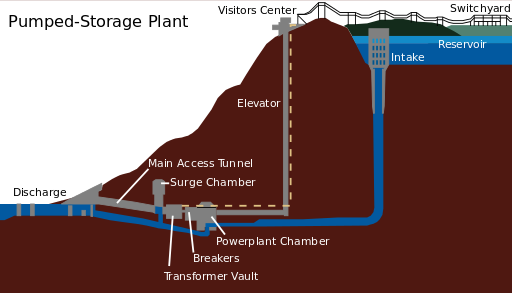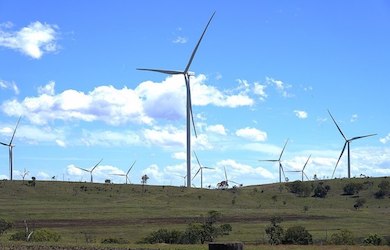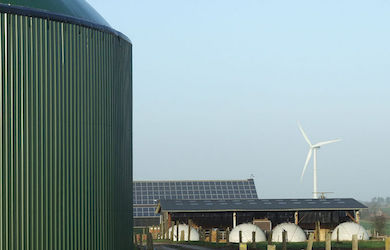Drax Group are planning a new pumped storage power station called Cruachan II in western Scotland adjacent to its existing pumped storage facility.
How Pumped Storage Works
Pumped storage power stations use two lakes with significantly different levels. When the electricity grid has surplus power water is pumped from the bottom lake to the top. When the grid needs more power water runs through generators from the top lake to the bottom adding electricity to the grid.
Figure 1 Section showing Racoon Mountain Pump Storage plant in Tennessee, United States [1]
Why Do We Need Pumped Storage?
Electricity needs to be available at all times with demand for it varying continuously through the day. Supply of electricity comes from multiple generators which can be intermittent and have limited reliability and flexibility. Pumped storage makes the overall electricity system more reliable by soaking up excess electricity and providing additional electricity thus matching the potential mismatch between supply and demand.
Whilst Pump Storage schemes only relinquish around three quarters of the energy they consume cumulatively they make a country’s electricity system more efficient and reliable.
How Does Pumped Storage Help Achieve Net Zero?
The main sources of carbon-free electricity are nuclear, wind and solar. None of these technologies (individually or collectively) is well placed to match electricity demand instantaneously. Conversely carbon-emitting sources of electricity (gas, coal and oil) are much better at matching national electricity demand.
This means that the mismatches in demand and supply are set to significantly widen as carbon-emitting generation is replaced with carbon free generation. This means the requirement for Pumped Storage is set to increase worldwide.
Alternatives
Other methods for managing the national mismatch between electricity demand and supply include batteries, demand side management and interconnectors. Battery storage systems can be relatively expensive but are more efficient and respond more quickly than Pumped Storage systems. They can also be located where electricity is used rather than where there are big lakes.
Demand side management can flatten out electricity demand throughout the day but electricity demand will always be variable. Running electric heating and charging cars at night helps flatten daily demand for electricity.
Interconnectors allow electricity to be moved from countries with surplus electricity with those that have deficiencies. There are significant power flows (mostly into) the United Kingdom from Norway, Netherlands, Belgium, France and Ireland.
Barriers to Deployment
The electricity market in the United Kingdom is not currently structured to make the development of Pumped Storage economically viable. Pumped Storage often makes more commercial sense in monopolistic electricity markets. Pump Storage systems also have significant environmental impacts as they move huge volumes of water between lakes in remote landscapes.
Cruachan II
Cruachan II will be able to generate up to 600 Megawatts (around 2% of UK electricity demand) and store up to 7.2 GigaWatthours (GWh) (around 1% of UK daily demand). The scheme will be adjacent to the existing Cruachan station that pumps water from Loch Awe to an upper reservoir at Ben Cruachan. The pumps and generators will be housed within an new man-made cavern in the mountainside.
Pumped Storage Around the World
Bath County is located in Virginia, United States having a capacity of 3,003 Megawatts was, until recently, the largest Pumped Storage scheme in the world. The largest scheme now is the Fengning Pumped Storage scheme in China’s Hebei province which has a capacity of 3,600 Megawatts.
Ireland has a pump storage facility at Turlough Hill in the Wicklow mountains which has a capacity of 292 Megawatts having become fully operational in 1974. South Africa’s Ingula Pumped Storage scheme (previously known as Braamhoek) has a capacity of 1,332 Megawatts and became operational in 2017. Ingula is located in KZN province north of Ladysmith.
Pumped Storage in Britain
Britain currently has four Pumped Storage schemes at Dinorwig, Festiniog, Cruachan and Foyers. Additional schemes are proposed at Coire Glas, Glenmuckloch, Muaitheabal, Glyn Rhonwy and Balmacaan.
Conclusions
Pumped Storage is an old technology which needs to be expanded to allow electricity generation worldwide to be carbon free. It is necessary for electricity markets and planning systems to be structured to enable new Pumped Storage development. Without more Pumped Storage carbon-free electricity is likely to be wasted in future.
About Pager Power
Pager Power undertakes technical assessments for developers of renewable energy projects and tall buildings worldwide. For more information about what we do, please get in touch.
References
[1] By Funkjoker23 – File:Pumpstor_racoon_mtn.jpg (March 2012) Wikimedia Commons, last accessed on 10th January 2021. Available at: https://commons.wikimedia.org/w/index.php?curid=18633057




